|
|
|
Sort Order |
|
|
|
Items / Page
|
|
|
|
|
|
|
| Srl | Item |
| 1 |
ID:
080743
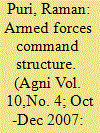

|
|
|
| 2 |
ID:
088755


|
|
|
|
|
| Publication |
Canberra, Department of Defence, 1997.
|
| Description |
vi, 66p.
|
| Series |
Australia's Strategic Policy
|
| Standard Number |
0644370009
|
|
|
|
|
|
|
|
|
|
|
|
Copies: C:1/I:0,R:0,Q:0
Circulation
| Accession# | Call# | Current Location | Status | Policy | Location |
| 039505 | 355.40994/AUS 039505 | Main | On Shelf | General | |
|
|
|
|
| 3 |
ID:
068660
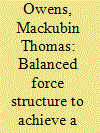

|
|
|
| 4 |
ID:
105883
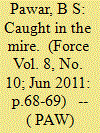

|
|
|
| 5 |
ID:
084601
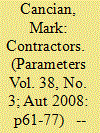

|
|
|
| 6 |
ID:
131240
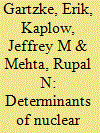

|
|
|
|
|
| Publication |
2014.
|
| Summary/Abstract |
A substantial literature examines the causes of nuclear proliferation, but few studies have addressed why states decide on a particular portfolio of weapon systems once they have acquired a basic nuclear capability. We advance a portfolio theory of nuclear force structure, positing that states seek a diverse set of capabilities for nuclear deterrence, but that they also face major resource and organizational constraints. A number of factors may help to explain the portfolio of nuclear forces that states ultimately field, including resource availability, experience as a nuclear power, bureaucratic politics, the conventional threat environment, the presence of nuclear rivals, and the maintenance of nuclear alliances. We test the influence of these factors on force structure using a new data set of nuclear weapon platforms fielded by nine nuclear nations between 1950 and 2000. Our findings represent an important step in understanding the drivers of nuclear behavior after states have joined the nuclear weapons club.
|
|
|
|
|
|
|
|
|
|
|
|
|
|
|
|
| 7 |
ID:
068910
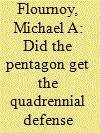

|
|
|
| 8 |
ID:
128609
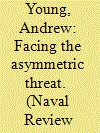

|
|
|
|
|
| Publication |
2013.
|
| Summary/Abstract |
Facing the asymmetric threat maritime counterinsurgency (COIN)
The author, starting from the primacy in maritime operations of maritime security argues that naval forces are ideally suited to counterinsurgency and asymmetric operations. He believes, however, that some changes in doctrine, mindsets and force structure will help to deal with these problems, which are a growing part of the maintenance of global and national security.
|
|
|
|
|
|
|
|
|
|
|
|
|
|
|
|
| 9 |
ID:
075815
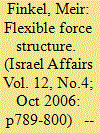

|
|
|
| 10 |
ID:
178640
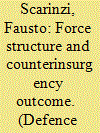

|
|
|
|
|
| Summary/Abstract |
This article examines the Cyprus Emergency (1955–1959) to test the force structure thesis. According to the thesis, armies that deploy more manpower per armored vehicle would succeed in counterinsurgency because they could win people’s trust, secure intelligence from civilians, and use force selectively. Using the congruence method of within-case analysis, I show that the causal process and logic of the force structure argument are not confirmed in the favorable case of Cyprus. Despite its preference for infantry and police units, the British garrison failed to win over the people and persuade civilians to share information about the insurgent; besides, Britain’s intelligence breakthroughs and selective violence did not result from the logic of the force structure thesis, nor did the conflict end as the argument would predict. Political conditions, instead, played a greater role. Ultimately, the case of Cyprus warns against the reassuring belief, inherent in the force structure thesis, that military organizational adjustments in favor of manpower can pave the way to victory against irregular opponents.
|
|
|
|
|
|
|
|
|
|
|
|
|
|
|
|
| 11 |
ID:
151398
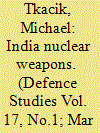

|
|
|
|
|
| Summary/Abstract |
This article argues India is laying the foundation to move away from “no-first-use” (NFU) as its nuclear weapons employment policy. Since the inception of its nuclear weapons program, India has claimed NFU as the centerpiece of its nuclear strategy. But India has a history of developing foundational changes to its nuclear weapons program before such changes actually occur. For example, the infrastructure of India’s nuclear weapons program was already being created in the 1950s under the guise of civilian nuclear power. Similarly, the weaponization of India’s program, which did not officially occur until after the 1998 tests, had its genesis in far earlier decisions. A close examination of trends in India’s nuclear weapons production complex, its delivery systems, and its command and control complex all lead to the conclusion that India is laying the groundwork for more flexible employment options, up to and including first use. This article does not argue such a decision has been taken. Rather, it argues the underpinning is in place to allow for a move to more flexible options, perhaps very quickly, at some point in the future. This could occur during crisis or it could occur incrementally over time.
|
|
|
|
|
|
|
|
|
|
|
|
|
|
|
|
| 12 |
ID:
061078
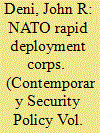

|
|
|
| 13 |
ID:
104766
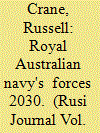

|
|
|
|
|
| Publication |
2011.
|
| Summary/Abstract |
Australia's navy has long been at the core of its defence posture, designed to secure its enormous littoral neighbourhood. The focus of all Australian military effects is domestic and, as such, jointery is at its heart. Chief of the Royal Australian Navy, Admiral Russell Crane, analyses the new White Paper and its implications for force structure, and personnel sustainability and management.
|
|
|
|
|
|
|
|
|
|
|
|
|
|
|
|
| 14 |
ID:
125877
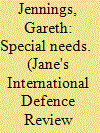

|
|
|
|
|
| Publication |
2013.
|
| Summary/Abstract |
Born out of disaster in the Iranian desert, AFSOC has proven itself to be a highly adept and flexible component of the wider special forces community.
|
|
|
|
|
|
|
|
|
|
|
|
|
|
|
|
| 15 |
ID:
104085
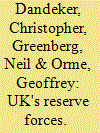

|
|
|
|
|
| Publication |
2011.
|
| Summary/Abstract |
This article focuses on how the role and structure of the UK's Reserve Forces have changed since their foundation before the First World War, with particular attention paid to the last two decades, during which time government has sought to make the Reserves more useable and relevant to post-Cold War military missions, including changing the legislative and administrative basis of their use. Since 9/11, Reserves have played an important role in the defense of the United Kingdom, particularly in operations in Afghanistan and Iraq, but the recent financial crisis has spurred further consideration of how best to structure and use this capability, which has been included as part of the recent Strategic Defence and Security Review (SDSR). The article analyses the current debate on whether the number of Reserve Forces should be cut or increased, and on how best to integrate their efforts with those of the Regular Forces. It also considers the evidence on the recent operational experience of Reserve Forces and its impact on a number of personnel issues, including recruitment, retention, and their health and well-being. The differences between the health and well-being outcomes for Reserve and Regular Forces are discussed and future lines of research enquiry highlighted, while the implications for the comparative analysis of Reserve Forces are also drawn out.
|
|
|
|
|
|
|
|
|
|
|
|
|
|
|
|
| 16 |
ID:
122611
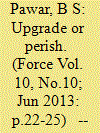

|
|
|
| 17 |
ID:
101330
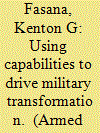

|
|
|
|
|
| Publication |
2011.
|
| Summary/Abstract |
Former cold war nations are grappling with how to transform their militaries in light of new strategic challenges. The implementation of these initiatives often requires a great deal of civil-military interaction. In developing transformational concepts, many of these countries rely on a functional view of capabilities. This article proposes an alternative capabilities model based on the interaction of effects, time, and space and asserts that this model has certain advantages vis-à-vis military transformation. To make its case, this article examines the effectiveness of both capability models in developing transformational concepts. It then uses the case study method to demonstrate the alternative model's practical utility. The results of this analysis indicate that the alternative capabilities model has certain advantages in developing transformational initiatives, integrating these initiatives with defense processes, and communicating these proposals to civilian leaders. The new model is not meant to replace but to complement the functional one.
|
|
|
|
|
|
|
|
|
|
|
|
|
|
|
|
| 18 |
ID:
144779
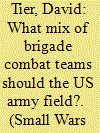

|
|
|
|
|
| Summary/Abstract |
During the past decade of war, the US Army has employed its forces in roles they were not intended to fulfill. The Army could have been better prepared if it had fielded a better mixture of forces. Instead of focusing on specific threats that narrowly specify which conflicts the Army will best be prepared for, the Army should maintain a broad range of capabilities that can meet a variety of circumstances. Accordingly, the Army should seek a force structure that exhibits a 3:1:1 ratio of Infantry, Armor, and Stryker brigade combat teams (BCTs) based on the possible range of conditions that US forces could face.
|
|
|
|
|
|
|
|
|
|
|
|
|
|
|
|
|
|
|
|
|